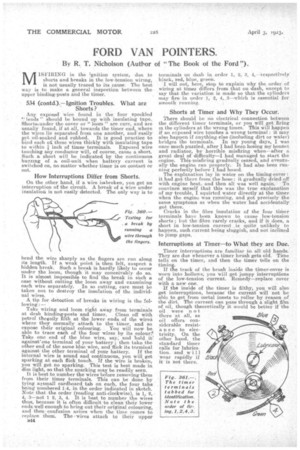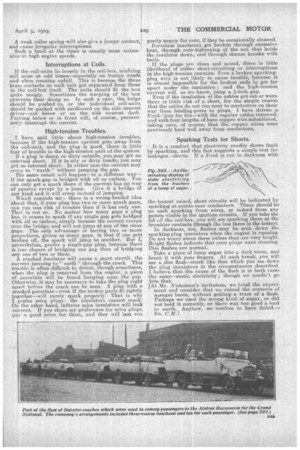FORD VAN POINTERS.
Page 28

Page 29

If you've noticed an error in this article please click here to report it so we can fix it.
By R. T. Nicholson (Author of "The Book of the Ford ").
IV!ISFIRING in the gnition system, due. to shorts and breaks in the low-tension wiring, is not usually traced to its cause. The best way • is to make a general inspection between the
upper binding-Posts and the timer. ,
534 (contd.),—Ignition Troubles. What are . Shorts?
Any exposed wire found in the four speckled "leads " should be bound up with insulating tape. Shortsz..under the cover or "loom " are rare, and are usually found, if at all, towards the timer end, ,where the wires lie separated from one another, and easily get oil-soaked and rubbed. It is good practice to bind each oi these wires thickly with insulating tape to within .1inch of timer terminals. Exposed wire touching any conductor will, of course, cause a short. Such a short will be indicated by the continuous buzzing of a coil-unit when battery current is switched on, no matter whether timer is on contact or not.
How Interruptions Differ from Shorts.
On the other hand, if a wire isabroken, von get an interruption of the circuit. A break of a wire under insulation is not easily detected. The only way is to bend the wire sharply as the fingers are run along its length. If a weak point is then felt, suspect a hidden break. Such a break is hardly likely to occur under the loom, though it may conceivably do so. It is almost impossible to find the break in such case without cutting the loom away and examining each wire separately. In so cutting, care must be taken not to destroy the insulation of the individual wires.
A tip for detection of breaks in wiring is the. following Take wiring and loom right away from terminals at dash binding-posts and timer. Clean off with petrol theioily filth at the lower ends of the wires where they normally attach to the timer, and so expose their original colouring. You will now be able to trace each of the four wires by its colour? Take one end of the blue wire, say; and hold it against" one terminal of your battery ; then take the other end of the same blue wire, and flick its terminal
against the other terminal of your battery. If the internal wire is sound and continuous, you will get
sparking at each flick touch. If the wire is broken, you will get no sparking. This test is best made in dim light, so that the sparking may be readily seen. ft is best to number the wires before removing them from their timer terminals. This can be done by tying azsmall cardboard tab on each, the four tabs
being numbered 14, in the order indicated in sketch. Note that the order (reading anti-clockwise), is 12 2, 4, 3—not 1 2, 3, 4. It is best to number the wires
thus, because it is often difficult to clean their lower endawell enough to bring out their original colouring, and then confusion arises when the time comes to replace them. The wires attach to their upper B44 terminals on dash in order 1, 2, 3, 4,--respectively black, red, blue, green. I will not, here, stop to explain why the order. of wiring at timer differs from that on dash, except to say that the variation is made so that the cylinders may fire in order 1, 2, 4, .,3—which is essential for smooth running,
Shorts at Timer and Why They Occur.
There should be no electrical connection between the different timer terminals, or you will get firing in the cylinders at the wrong times. This Will happen if an exposed wire touches a wrong terminal : it may also happen if anything else (including dirt or water) bridges the terminals. In my young days, I was once much puzzled, after I had been hosing my bonnet and radiator, by horrible misfiring when—after a great deal of difficulty—I had managed to start the engine. This.misfiring gradually ceased, and eventually the engine rap properly. It had also been running perfectly before I had hosed.
The explanation lay in water an the timing-cover : it had got there from the hose : it gradually dried off with engine heat, and then all was well again. To convince myself that this was the true explanation of my trouble, I squirted water directly at the timer when the engine was rnnning, and got precisely the same symptoms as when the water had accidentally got there. Cracks in the fibre insulation of the four tinier terminals have been. known to cause low-tension shorts ; but the fibre rarely cracks, and if it does, a short in low-tension current is quite unlikely to happen, such current being sluggish, and not inclined to jump gaps.
Interruptions at Timer—to What they are Due.
Timer interruptions are familiar to all old hands. They are due whenever a timer brush gets old. Time tells on the timer, and then the timer tells on the find ng.
If the track of the brush inside the timer-cover is worn into hollows; you will get jumpy interruptions of the low-tension current. Remedy—replace cover with a new one.
If the inside of the timer is filthy, you will also get interruptions, because the current will not be able to get from metal insets to roller by reason of the dirt. The current can pass; through a slight film of oil, though theoretically it would be better if the oil were not
there at . all, as Noe oil offers considerable resistance to electricity. On the other hand, the standard timer calls for lubrication, and will wear rapidly if cf/ it is not there.
A weak roller spring will also give a jumpy contact, and cause irregular interruptions. Such a fault at the timer is usually most noticeableiat high engine speeds.
Interruptions at Coils.
If the coll-units lie loosely in the coil-box, misfiring will arise at odd times—especially on bumpy roads and when running uphill. This is because the three brass contacts on each unit get separated from those in the coil-box itself. The units should fit the box quite snugly. Sometimes the warping of the box prevents their doing so. In such a case, the bulge should be pushed in, or the individual coil-units should be packed with cardboard on the side nearest driver—not below or on the side nearest dash. Packing below or in front will, of course, permanently interrupt the current.
High-tension Troubles.
I have said little about high-tension troubles, because if the high-tension cprrent gets away from the coil-unit, and the plug is good, there is little fear of trouble in the high-tension part of the system_
If a plug is damp or dirty outside, you may get an external short. I it is oily or dirty inside, you may get an internal short. In seither case the current may creep to " earth " without jumping the gap.
The same result will happen—in a different way— if the spark-gap is bridged with oil or carbon. You can only get a spark there if the current has no way of passing except by a jump. Give it a bridge of any kind and it will creep instead of jumping. Which reminds me : there is a wrong-headed idea about that, if your plug has two or more spark gaps, von run less risk of trouble than if it has only one. That is not so. No matter how many gaps a plug has, it ceases to spark if any single gap gets bridged with oil or carbon, simply because the current creeps over the bridge, and will not jump at any of the clear _gaps. The only advantage of having two or more projections, giving as many gaps, is that if one gets broken off, the spark will jump to another. But nevertheless, prefer a single-gap plug, because there is less chance of bridging one gap than of bridging any one of two or three.
A crack-ed insulator will .cause a short circuit, the current jumping to "earth" through the crack. This trouble is often difficult to detect, though sometimes, when the plug is removed from the engine, .a piece of porcelain will be found hanging near the gap Otherwise, it may be necessary to take the plug right apart. before the crack can be seen. A plug with a cracked porcelain—even if the broken parts fit tightly together—will rarely spark properly. That is why I prefer mica plugs :. the insulators cannot crack: On the other hand, inferior mica insulators will leak current. If you share my preference for mica plugs, pay a good price, for them, and they will last You
pretty nearly for ever, if they be occasionally cleaned. Porcelain insulators get broken through excessive heat, through over-tightening of the nut that holds insulator nsulator down, and through chance knocks with tools.
If the plugs are clean and sound, there is little likelihood of either short-circuiting or interruptions in the high-tensian curcuits. Even a broken sparkingplug wire is not likely to cause trouble, because it is almost impossible for the broken ends to get far apart under the insulation ; and the high-tension current will, as we know, jump a. +-inch gap.
Even if the insulation of the cables get cut or worn there is little risk of a short, for the simple reason that the cables do not run near to conductors on their way from binding-posts to plugs. I have driven a. Ford—just for fun—with the regular cables removed, and with four lengths of bare copper wire substituted, taking care, of course, that the copper wires were previously bent well away from cond.uctors,
Sparking Tests for Shorts.
It is a comfort that electricity readily shows itself by sparking, and this fact suggests a simple test for leakages—shorts. If a Ford is run in darkness with the bonnet raised, short circuits will be indicated by sparking at-points near conductors. 'There should be no such sparking from wires, or indeed from any points visible in the ignition ciredits. If you take the lid off the coil-box, you will see sparking there at the i trembler contacts (though the less there s the better). In darkness, too, flashes may be seen down the sparking-plug insulators when the engine is running. Do not worry about these unless they are very bright. Bright flashes indicate that your plugs want cleaning. Dim flashes are normal.
Take a piece of lump sugar into a dark -room, and break it with your fingers. At each break, you will see a dim flash—much like that which you see down the plug insulators in the circumstances described. I believe that the cause of the flash is in both cases the same—static electricity ; though we needn't go into that.
[At Mr. Nicholson's invitation, we tried the experiment and consider that we ruined the contents of aasugar basin, without getting a trace of a flash. Perhaps we used the wrong kind of sugar, or did not hold it correctly, or there was too good a lead to earth. Anyhow, we 'confess to have failed.— En. .C.M.1
































